Everything you need to know about setting a business goal for 2015!
Written by Julia Bickerstaff // December 2, 2014 // Daily Juice // 1 Comment
Oh Hello! We’re crafting a 2015 plan for our businesses in just five easy steps. Are you with me? Here’s step two: setting a Business Goal. If you missed step one you can find it here!
You can now get the 5 Step Plan as a PDF! Hurrah! Just click here!
Why having a goal is super-important
I’ve not always been very good at setting goals. Especially business-y ones. But a few years ago I started doing it properly, and oh goodness! The difference!
It’s not rocket-science: everyone tells you to set goals and then work towards them but the thing is if you REALLY want to do something, setting it as a goal works. IT REALLY WORKS!
The magic is finding a goal YOU really want to do. That’s YOU, not your partner or your Mum or your friend or cos ‘everyone expects you to do it’. It’s gotta be something that’s just important to you!
When you set a goal you REALLY want to achieve it almost becomes a self-fulfilling prophecy because the goal:
- Ensures you focus your time on activities that’ll help you reach your goal rather than all the fun but irrelevant stuff!
- Energises you. When you really want to achieve something it’s amazing how you can find the energy to do it!
- Help you make the right decisions – it’s much easier to decide whether to do something or not by asking “Will this help me reach my goal?”
- Helps you think more clearly. Once you’ve got a goal it’s amazing how many creative ways you can find to achieve it!
- Makes you persistent. We all have knock backs but you bounce back up again when you really want to achieve something!
Agree?!
How to set your business goal for 2015
I think it’s super-important to have ONE big overarching goal for the year. That one thing you really really really want to achieve.
Only ONE goal?
YES! For your 2015 business plan, pick just ONE big goal! You can have lots of little goals that add into that one goal but you only want to have ONE main goal. Believe me, if you really want to achieve something you’re better off focussing 100% on that one thing than spreading the love around!
What makes a good yearly goal?
Let’s not make this too complicated! The very best yearly goals are:
- Something you REALLY want to achieve. YES! Like I said above, your goal needs to be something that’s so important to you that you’ll keep ploughing away it it even when you don’t feel like it! You’ve gotta really want it!
- Measurable. OK so this is super-important. You MUST be able to measure your goal so you know whether you’ve achieved it and so you can see your progress. And make sure it’s easy to measure – ideally you want to be able to measure your progress monthly and weekly and even maybe daily!
Financial goals
Because we’re talking business here, I honestly think the best BIG goal you can set is a financial one. For me it’s very important that I earn a certain amount of money from my business. And I’m sure if you really want to keep on running your business, it’s important for you TOO!
Some of us feel a bit squiffy about setting financial goals. What we really want to do is help our customers, do good work or make nice things. But we can only continue to do that if we make money, right? So the money bit enables us to do the work we love! Money stuff is important and it makes a good goal!
But, but, but……, you need to pick a goal that YOU really want to achieve so if a money goal is not your thing, pick something that suits you better.
A profit-y type of goal
So, if you’re OK with setting a financial goal what sort of financial goal should you set? The two obvious ones are Sales Revenue and Profit. Sales Revenue is the easiest to measure but profit is what’s important to us. Have I confused you? Maybe. Here’s an example that will help!
So setting your goal as Sales Revenue might be a bit misleading if what you’re really after is making a healthy profit. But profit is a difficult goal to measure regularly. So what’s a girl to do?
Well you can try this:
How to turn your Profit goal into a Sales Revenue goal
Here’s a way to turn your Profit goal into a Sales Revenue goal. This means you can measure your Revenue (easy) but know you are working towards a goal that makes you a good profit too!
First of all a little note about numbers:
The profit you make in your business is your Revenue less all your costs. Accountants separate these costs out a bit to make it easier to think about them. Sometimes we do it like this:
- Cost of sales is the cost of making and delivering the product you sold
- Overheads are the general running costs of the business (like telephone, internet, hosting, bookkeeping etc)
- Other costs are, well, other things. Like marketing, say.
To work out your Sales Revenue Goal we’re going to use this way of looking at your numbers but we’re going to turn it upside down! We’re going to start with your profit goal and work back to find out what Sales Revenue you need to make to earn it!
So the example above would look like this.
Here’s how to do it yourself:
Here’s how you do it. If it sounds a bit confusing just skip to the example below!
1.Start with the profit you’d like to make
2.Add to that your overhead costs and any other costs that aren’t directly a cost of your product
3.The number you’ve now got is your Gross Profit.
4.Now we need to work out what your sales revenue needs to be to generate this Gross Profit. To do that we need to know what your usual Gross Margin is. Gross margin is the profit you make on the sale of an item. So it’s your Sales Price less the cost of making/delivering the product. To make this number usable we turn it into a percentage of the sales price. Like this:
5. Are you still with me?! In Step 3 we worked out the Gross Profit you need your business to make; now we can work out what sales revenue that equates to by just dividing the Gross Profit by the gross margin%! Like this:
6. Ta-da – you’ve now worked out the Revenue goal that equates to your Profit Goal. You can now make that Revenue number your big goal. This makes life much easier as while it’s tricky to measure profit on a daily or weekly basis it’s simps to measure your daily sales!
7. Careful though! This short cut assumes that you keep your average gross margin pretty steady. If you lower your prices dramatically this WON’T work. Why? Because when you lower your price, the gross margin on the sale of each item gets smaller, which in turn means you need to sell more to make the same gross profit. Just remember that if you start discounting in the year!
Here’s an example!
I hope I haven’t confused you. Here’s an example to make it clearer:
Does this make sense?! Fancy giving it a try to work out YOUR revenue goal?
Can I use ‘number of sales’ instead?
If you sell lots of the same thing for roughly the same price – like girls dresses say – then you could make your BIG goal the number of dresses you sell.
But you can only do this if the dresses are the same price and have the same margin. If you sell things which earn you quite a different price (like me – I sell books at $25 each and coaching at $400 a session!) then clearly you can’t just count the number of items you sell.
I like the idea of tracking the number of sales. I call it the ‘number of customers served’ which sounds nicer and less sales-y. But I do keep an eye on the profit side of things and that has to be my number one BIG goal as I want to stay in business!
Non-financial goals
Maybe you have an important goal that you really want to achieve, but that’s not financial. Of course it’s fine to use that instead. The most important thing when setting a goal is for it to be something you WANT to achieve. Just make sure you know WHY you want to achieve it though!
For example you might have a BIG goal of reaching 50,000 fans on Facebook. That’s a very measurable goal and easy to track your progress. But is achieving it the most important thing for you to do next year?! It’s your call!
Good, great awesome!
Last tip!
One of my fave things to do with my BIG goal is to make it a little bigger! Why? Well I’ve learned that while with effort we often meet our goals we rarely exceed them. Crackers but true. It’s kinda like our brain sets the goal as the limit which it then refuses to pass!
So you might want to try this to trick your brain into aiming higher!
- Take the goal that you worked out above. Call that your GOOD goal.
- Now make it 10% bigger. Call that your GREAT goal.
- Now make it 25% bigger. Call that your AWESOME goal.
Write these three goals down on a piece of paper and put the paper away in a safe place until this time next year.
For the rest of 2015 aim for your AWESOME goal! You might reach it! If you don’t you’ll probably make the GREAT goal which will be totally fabulous and if you miss that you’ll hit GOOD, which is what you wanted anyway!
Try it, it WORKS!
Next time
Next time we’re doing Step Three: Working out your Themes!
♡ YOU?! ♡
Are you going to set a financial business goal or have you something different in mind? How good are you at sticking to your goals?!
You can now get the 5 Step Plan as a PDF! Hurrah! Just click here!
PS This is part of a series I’m doing about crafting a super-simple plan for your business! If you don’t want to miss the next one you can get it in our weekly FREE Snacks email!

Fancy getting a weekly Snack of sweet stuff for your small business? Just pop your details in below.

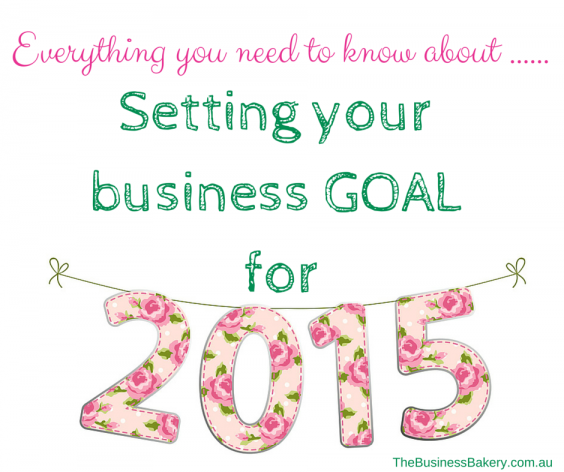

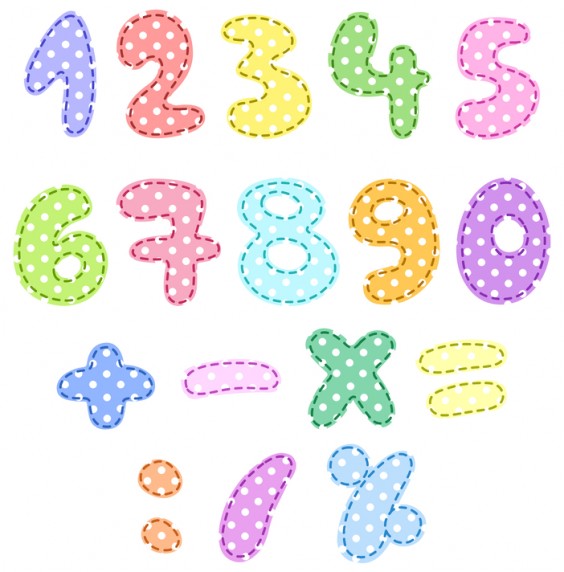





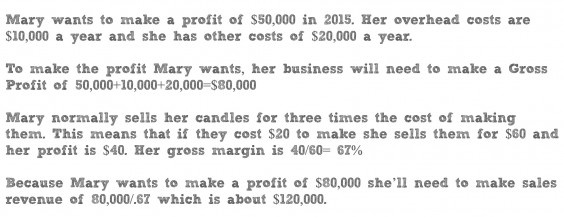
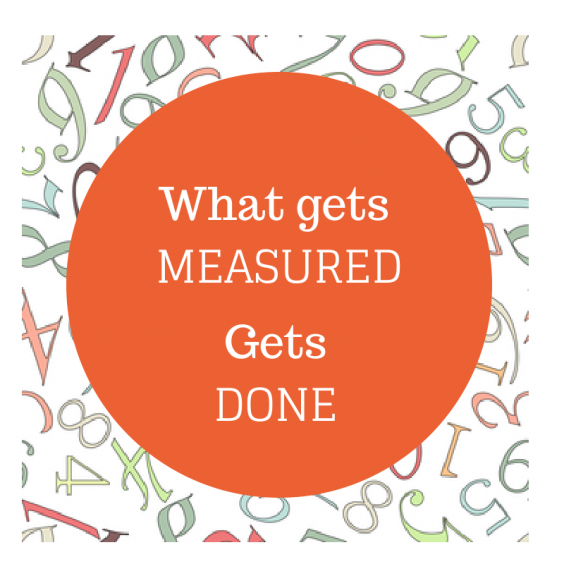

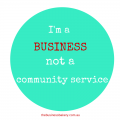
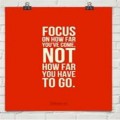


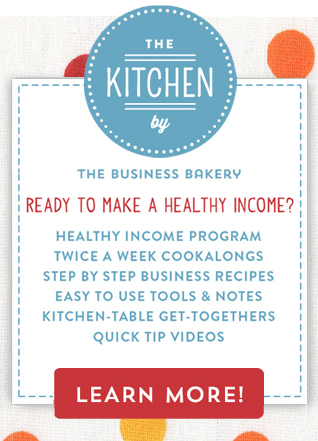

















One Comment on "Everything you need to know about setting a business goal for 2015!"
This gave me a light bulb moment!
I worked out the profit and cost margin on all my products (unit price). Then rather than take an annual salary as my goal, I decided on £100, just because my items are mostly under £100 each and lots of zeros confuse me. And if I had to make 20000 of something I’d give up straight away.
I now know how many of each product will give me £100 profit so I now have a stock level to work too (7 items with £14 profit). With the 25% awesome goal, this is just 2 more items.
Starting next year, I am going to have a stock of and make £100 worth of each item, and when they are sold, make another set. Also keeping count will be easier too as rather than counting individual items, they all equate to a £100 unit, eg in Jan I sell 1, 0.5 and 2 units, that is £350 profit. I may just record whole units as parts will get messy. So it may be a couple of months before 1 unit is completely sold. And seasonal events will result in increased sales too. So it will all balance out.
Thank you Julia, for giving me a way to simplify things and be able to work With numbers in a way I understand.